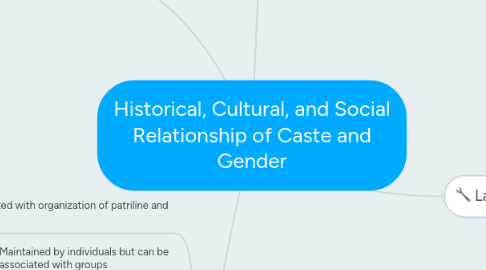Historical, Cultural, and Social Relationship of Caste and Gender
by Britt Smith


1. Work
1.1. Artisan and domestic work
1.2. Artisan:
1.3. Women can inherit work from their husbands
1.4. Women in lowest castes are trained by their parents
1.5. Inheritance of skills limited to lowest groups
1.6. "Occupational work"
1.6.1. label found in literature
1.6.2. overemphasis due to :
1.6.2.1. history of low caste landlessness
1.6.2.2. dependency on upper caste patrons
1.6.2.3. artisan work in peasant economy
1.7. Domestic:
1.7.1. childbearing, cooking, cleaning
1.8. Women only do domestic work
1.9. Low and high caste women do equal amounts of reproductive work
1.10. Escapes the confines of caste and determined mostly by gender
2. Honor
2.1. associated with organization of patriline and caste
2.2. Maintained by individuals but can be associated with groups
2.2.1. honor of a group can depend on women
2.3. Evidence of honor includes:
2.3.1. abundance of: land
2.3.2. people
2.3.3. produce
2.3.4. health and happiness
2.3.5. good fate
2.4. Patrilineal honor manifested around kinship, sexuality, commensality, and birth
2.5. Giving and generosity are highly valued and honored
2.6. Linked to dharma
2.6.1. moral duty
2.7. Low caste women stereotyped as more sexually free
3. Land
3.1. Land=power
3.2. Change from informal verbal agreement of land to written agreement
3.3. Written agreement created division between castes
3.4. Written documentation made it so women could not longer informally inherit land
3.5. Women therefore remain landless and powerless
4. Labor
4.1. Over the past century low caste women have experienced changes in the kinds of work they do
4.2. Gradual replacement of artisan related production to paid agricultural and nonagricultural work
4.3. Negatives to these changes
4.3.1. become free laborers
4.3.2. breakdown of patron client intercaste relationships
4.3.3. informal daily wage labor in context of increasing poverty
4.4. Positives to these changes
4.4.1. economic power in their homes and communities
4.4.2. economic power tied to role of acquiring rental land for farming
